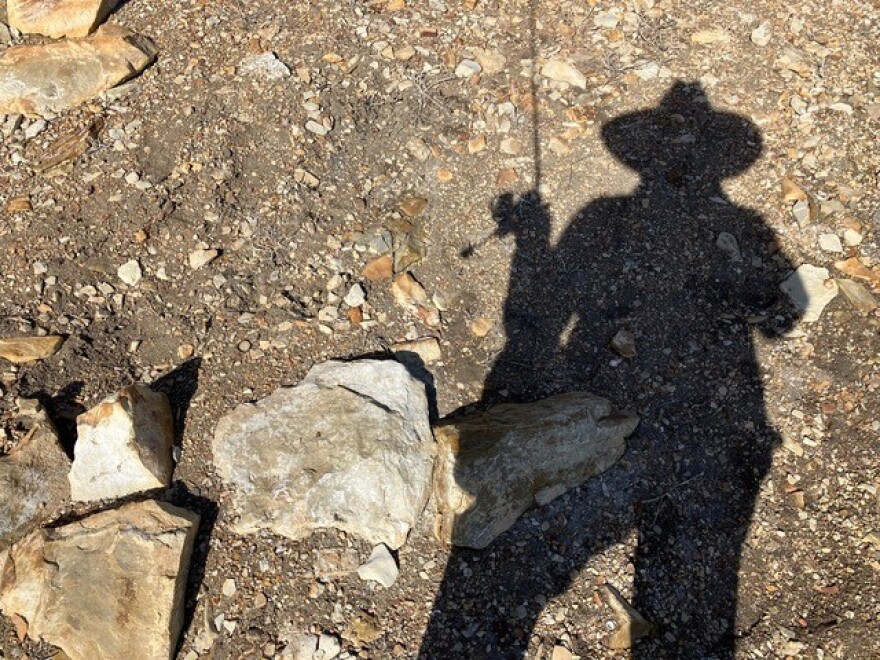OK, there. Finally. I found it. My first pasqueflower of 2023.
Let spring begin!
I’m talking about spring of the heart, of course, not spring of the calendar. That calendar spring has been around for three weeks or so, although it was often hard to tell.
It was a long winter for most of us here in South Dakota, miserable in many ways. Then it was followed by a volatile, mostly disappointing early part of calendar spring.
Take last Tuesday. It was 25 degrees here and we got something like 14 or 16 inches of snow. Overnight the temp was in the teens. So it was cold. Winter cold. Cussin’ cold, if a person were inclined to cuss.
Then take this Tuesday. It was 85 here and the wind was howling. A hot wind. Summer hot. Or as Martin the GEICO lizard says when he tastes the sizzling sauce on a place of southern buffalo wings: “Oh, it’s too hot, mate!”
And 85 degrees in early April was just too hot, too, mate!
I don’t like either 25 or 85 this time of year. Each in its own way messes with my spirit and with my springtime plans, including those that involve pasqueflowers, and walleyes.
What do the state flower and the state fish — both designated as such in law — have in common? Plenty, if you’re me and you’re looking for spring. The one of the heart, I mean.
In their own ways, the extremes we experienced in the last week reflect the increasing extremes of our weather as the earth continues to warm. Yes, of course, we’ve always had extremes. But we have more of them now, and they’re more extreme.
Most reasonable people have stopped arguing about the realities of climate change. The argument now is what to do about it. How much are we willing to spend and sacrifice now to address climate change? How much do we want to leave for our grandchildren to live with and try to clean up?
Waiting for those purple heads to show
Those are much-bigger issues than the superficial I have about unruly spring weather messing up my outdoor plans. But while not of climate-change importance, these things nonetheless matter to my mood and to my manner of being. And maybe they matter to yours, too.
Harbingers help. And robins are probably the most celebrated signs of spring. Western meadowlarks rank high, too, higher than robins for me. Their sweet, conversational song is a better bet that spring is here to stay than the appearance of robins in your backyard.
I enjoy the robins, and trust the meadowlarks. But for me spring really arrives when I find my first pasqueflower.
That’s spring of the heart in full bloom.
In my part of the Black Hills and, particularly, along the Skyline Drive trail system near our home in central Rapid City, pasqueflowers usually start to show their purple faces in the middle of March.

I usually start walking the trails in search of pasques in early March, if the weather and conditions on the trails allow it. That’s pushing the pasque season a bit, but the pasques are pushy little plants themselves. They seem to like life on the edge, which sometimes is the edge of a snow drift.
The persistent perennials spread from seeds but also form clumps from taproots that produce new plants and flowers year after year. On that point I called retired state Game, Fish & Parks Department botanist Dave Ode of Pierre for more information. He told me that pasqueflower taproots can live more than 10 years and maybe 20 years.
A pasqueflower clump might send up several stems that produce flowers. So usually when the flowers are close together, they’re from the same taproot. A pasqueflower community is like an aspen grove with its interconnectedness.
Drought, especially in the fall, can hurt regeneration of pasqueflower communities the following year. But usually if you find pasques in an area one year you will find some there the next.
I like knowing they’re out there, safe underground, throughout the winter, just waiting to poke their heads up for spring.
Almost always by the time spring arrives on the calendar, a few pasques will be showing up in the forest above us. Much earlier is an unusual gift, much later a disheartening delay. This year the pasques have been delayed. And in that, they’ve had some company.
Zen in a pair of waders, or yoga with rod in hand
Take the walleyes. Or, more specifically, my walleye fishing.
At about the same time I usually find my first pasque each spring, I also usually take my first trip to Angostura Reservoir near Hot Springs to cast for walleyes. If I catch a walleye or two, that’s great. And it’s really good news for our supper options.
But I don’t have to catch anything to make the first walleye trip a celebration of the season. And after several weeks of delay because of the weather, I made my first trip to Angostura on Monday. It was one of many casts and no walleyes. No bites, even.
It gave me a feel for how cold the water is, however, and why the walleyes are so slow to get active. Instead of my insulated waders, I was wearing uninsulated hip boots over my jeans. And the medium-weight Smartwool socks weren’t quite enough to keep my feet warm for long.

Even so, I enjoyed sloshing around in the shallows and checking out my fishing gear. Most of all, I got to feel the bump-bump-bump signals being sent to me through the monofilament line from the lead-head jig I was bouncing slowly along the bottom.
Minnows or night crawlers would have improved my chances. But I don’t use live bait much anymore, unless one of the grandkids demands it. It’s so much simpler to carry a spinning outfit and a little bag of jigs and wander through shallows on foot, casting and considering things.
The rhythmic cast-and-retrieve process offers a tactile connection with the world beneath the surface of the lake that’s hard to match.
Zen in a pair of waders? Yoga with a rod in hand? Maybe. Saying hello to spring? Definitely.
Talking the talk while casting a jig
I was knee deep in Angostura and lost in that connection when I heard a greeting from behind me. A guy about my age was holding a fishing rod and reel in one hand and stretching the other hand out to simulate the measurement of a big fish.
It was a question without words.
He grinned. I grinned back, shook my head and said: “I got nothing. Hours of casting. Not a bite.”
He considered that with a look of mournful resignation and said: “Yeah, it’s too early. But I wanted to fish anyway.”
I nodded my agreement and made another cast. And another. And another.
The guy watched, then offered hope with, as you might expect, a fish story: “I was right out in front here last winter, and caught a big walleye through the ice. Just came down late in the afternoon and drilled a hole and got a 24 1/2-incher. On that little ice rod. I could barely get him up through the hole.”
He smiled. So did I.
“I’d sure take a 24 1/2-incher,” I said.
The guy watched me cast a while more and made a couple casts himself. When I looked back a few minutes later, he was gone. Maybe that was enough. Or maybe he had another spot to try.
Me? I figured that after a week of fighting a cold, that was enough wading and casting. I walked back to the pickup, took off the hip boots, drove out of Angostura State Recreation Area and headed north on Highway 79.
There’s a lot to look at and plenty to consider on the drive back from Angostura, including the front range and foothills of the southern Black Hills. It’s beautiful country, marked by charming foothills ranches and pastures grazed by cattle, mule deer and antelope.
Gosh, I hope those foothills and pastures and ranches can survive the onslaught of rural housing development.
I thought, too, about returning to Angostura the next day for more casting. But the forecast of 80-plus degrees and strong winds made that idea unappealing. Besides, I was scheduled to be the altar server Tuesday at noon mass at St. Issac Jogues. And I had some writing to do, mainly for this blog.
Looking for a blog column, and spring of the heart
So I stayed home Tuesday and mulled some column ideas. My first casting trip to Angostura hadn’t helped me much there. It wasn’t just that I hadn’t caught anything. I hadn’t seen anything really unusual — something strange washed up on the beach; a type of bird I hadn’t expected; a kid who caught a big fish; or a hognose snake near the main marina boat ramp.
On that last one. Yeah, I I saw a hognose snake — my first outside of the Reptile gardens — near the main marina boat ramp few years back. A young guy doing angler surveys for Game, Fish & Parks found the snake near the ramp and had it in a plastic bucket.
If I remember right, the guy was a student at BHSU and was involved in research on Black Hills snakes. After his GF&P shift, he planned to study the snake more in detail before releasing it.
That would have been some column material. And maybe it will be, some day.
But for this week, my friend and South Dakota Public Broadcasting colleague Lori Walsh and I were texting back and forth about possible topics for my blog and for our public radio discussion on In the Moment. I was sitting at my computer in the den, gazing out the window when I noticed a woman and a dog heading up the street toward the trails above.
And I thought: “Pasques!”
Twenty minutes or so later, I was up on the Skyline Drive trails. I was searching along the trail as I walked up into the hills. But mainly I was heading for my best bet for early pasques: a rocky slope that catches full sun for most of the day.
Once there, I looked in the places I’d always found pasques and within a few minutes caught sight of a tiny bit of purple backlit by the sun above me 30 feet or so on a rocky slope.
“There you are,” I said softly, as I picked my way carefully up the slope to where I’d seen the tiny flash of color. I found a pasqueflower clump with three lovely blooms shimmying slightly in the breeze.
I paused to celebrate and take some cell-phone pictures. Then I resumed my hike, passing through several areas of the trail system that had been in previous springs been covered with blooming pasques.
I didn’t see another pasqueflower. They’ll be coming soon, though.
And for now, that clump and those three lovely flowers were enough.
Spring is finally here.



